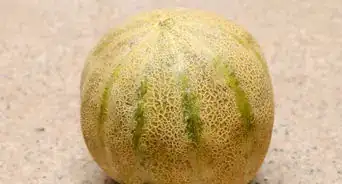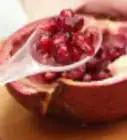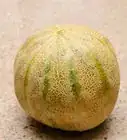This article was co-authored by Ollie George Cigliano. Ollie George Cigliano is a Private Chef, Food Educator, and Owner of Ollie George Cooks, based in Long Beach, California. With over 20 years of experience, she specializes in utilizing fresh, fun ingredients and mixing traditional and innovative cooking techniques. Ollie George holds a BA in Comparative Literature from The University of California, Berkeley, and a Nutrition and Healthy Living Certificate from eCornell University.
This article has been viewed 29,357 times.
Pomegranate seeds are a crunchy, flavorful, ruby-red addition to dishes both sweet and savory. Removing them from the fruit and cleaning them can seem tricky, but it’s actually pretty simple once you get the hang of it. With a few quick tricks, you’ll have your pomegranate seeds cleaned and ready to eat in no time.
Steps
Opening the Pomegranate
-
1Cut a cone shape into the top to remove the flower end. Hold a chef’s knife at a slight angle, right next to the flower end of the pomegranate. Cut around the flower in a circle to remove a cone-shaped piece of fruit, then set it aside.[1]
- The flower end of the pomegranate has a small blossom growing out of it is.
-
2Slice off the stem end at the bottom. Turn the pomegranate over and locate the stem, which is small, brown, and circular. Hold the knife’s edge just to the side of the stem and slice it off in a thin, disc-like shape.[2]Advertisement
-
3Slice the skin, but not the flesh of the fruit, along ridges on the sides. Look at the pomegranate from the top and locate soft ridges or bulges on the side of the fruit, running from the flower end to the stem end. Skim your knife along each ridge, cutting through the hollowed-out cone at the flower end and running it down to the stem. Press down just hard enough to slice through the skin, but not the fruit itself.[3]
- There should be 4-6 ridges on your fruit.
- The pomegranate will naturally separate along these ridges, making it easier to cut and open the fruit.
Tip: If you’re having trouble finding the ridges, you can simply cut around the width of the pomegranate instead. It’ll be more difficult to pull apart, but you should still be able to open it up.
-
4Pull apart the pomegranate pieces with your hands. Hold the pomegranate in both hands and push your thumbs into the cuts along one section. Gently pull it apart with your hands to loosen and remove the section, then repeat for the remainder of the fruit.[4]
- Pull the sections apart gently to avoid spilling any seeds. If a few do get loose, gather them up on your surface so you can clean them.
Removing and Cleaning the Seeds
-
1Place the pomegranate sections in a bowl of water. Fill a large mixing bowl with warm water, enough to fully submerge your pomegranate pieces. Set them in the water, going 1 or 2 at a time if your bowl is smaller.[5]
- If any seeds fell out of your pomegranate while you were opening it, place those in the water as well.
Did you know? The warm water will help to soften the white flesh inside the pomegranate, called the pith, making it easier to pull it away from the seeds.
-
2Push the edges down to open up the fruit and release the seeds. Keep the section submerged and use your hands to push down on the edges. Pull them away to expose the seeds and let them drop into the water.[6]
- Besides making it easier to open the fruit, the warm water will also wash the seeds.
-
3Hit the back of the pomegranate to knock out more seeds. Take the section out of the water and turn it upside down, so the skin is facing out. Hold it over the water and hit it firmly with the back of a spoon to knock out any seeds still attached. Let the seeds fall into your hand or the water below.[7]
- Whack the section 3-4 times, or until most of the seeds have fallen out.
-
4Remove any last seeds with your hands and place them in the bowl. Turn the pomegranate over again and inspect it for any last seeds. Pull them out with your hands or use the spoon again to knock them loose, then place them into the water with the rest.[8]
-
5Scoop out the pieces of white pith with a slotted spoon. The red pomegranate seeds should sink to the bottom of the bowl, leaving the white pith to float on top. Use a slotted spoon or sieve to remove these from the water.[9]
- If the pieces are large enough, you can also pick them out with your hands.
-
6Drain the water and eat or store your pomegranate seeds. Drain the water from the pomegranates using a colander. If you don’t have a colander, place a flat surface like a cutting board or lid over the opening of the bowl, leaving a small slit open at the bottom, and drain the water through the opening into the sink. Your pomegranate seeds are now cleaned and ready to eat![10]
- You can also store the seeds in an airtight container. Place them in the refrigerator for 5 days, or freeze them for up to 3 months.
Things You’ll Need
- Chef’s knife
- Mixing bowl
- Warm water
- Airtight container, for storage
References
- ↑ https://www.youtube.com/watch?v=1iHbSzM63Hs&feature=youtu.be&t=19
- ↑ https://www.youtube.com/watch?v=1iHbSzM63Hs&feature=youtu.be&t=52
- ↑ https://www.youtube.com/watch?v=1iHbSzM63Hs&feature=youtu.be&t=64
- ↑ https://greatist.com/eat/pomegranate-deseed-trick
- ↑ https://www.thekitchn.com/my-favorite-way-158527
- ↑ https://greatist.com/eat/pomegranate-deseed-trick
- ↑ https://greatist.com/eat/pomegranate-deseed-trick
- ↑ https://greatist.com/eat/pomegranate-deseed-trick
- ↑ https://www.thekitchn.com/my-favorite-way-158527
About This Article
To clean a pomegranate, first cut off both ends of the fruit. When these are gone, slice about 5 ridges in the skin from the flower end to the stem end of the pomegranate. Once you’ve cut the ridges, pull apart the pomegranate in these sections and fully submerge them in a bowl of warm water, which will help open the fruit and wash the seeds. To release all the seeds, push down on the fruit’s edges or hit the back of each section with the back of a spoon. You can also pull out any remaining seeds with your hands. As the seeds sink to the bottom of the bowl, spoon out any floating white pith. Once all the pith is removed, drain the water from the bowl using a colander so you’re left with the clean seeds. For more information, including how to store pomegranate seeds, scroll down!



















































